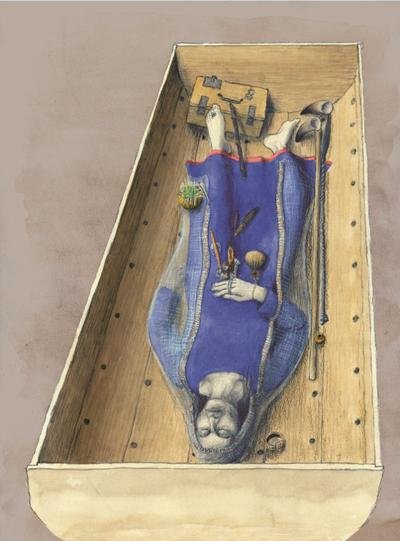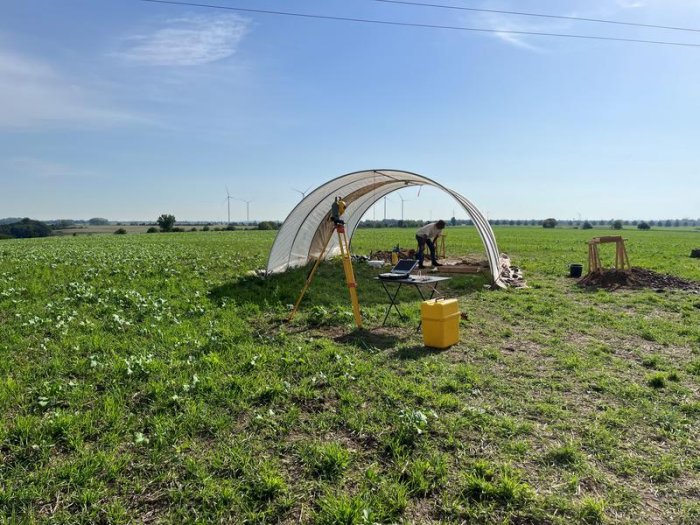Mysterious 9,000-Year-Old Shaman Burial In Bad Dürrenberg – One Of Central Europe’s Most Spectacular Archaeological Discoveries
Ellen Lloyd - AncientPages.com - About 9,000 years ago, an influential and respected woman was put to rest in a burial in Bad Dürrenberg, Germany. She was buried in a sitting position with a child of about six months in her arms. The child was not hers, and there is no evidence the baby had been sacrificed. Her spectacular clothes and lavish burial offer evidence she was a woman of high social status. We do not know her name, but we know she was 30-40 when she died.
A reconstruction of the female shaman's headdress. Image courtesy: State Office for Heritage Management and Archaeology Saxony-Anhalt, Karol Schauer.
Her grave was located in Bad Dürrenberg, a town in Saxony-Anhalt. It is today referred to as one of the most spectacular discoveries in Central European archaeology.
When examining the ancient grave goods, scientists could determine the woman buried in Bad Dürrenberg was a shaman.
Shamanism is an ancient and powerful spiritual practice that dates from humanity's earliest beginnings. Some say shamanism is the "ancestor" of all our modern religions.
"The word "shaman" comes from the language of the Evenki peoples, a Tungusic tribe in Siberia. This is a word whose meaning has to do with esoteric knowledge and extraordinary spiritual abilities and as such a shaman is often defined as an intermediary between the human and the spirit worlds. In shamanic cultures, the word "shaman" has come to mean "the one who sees in the dark" or "the one who knows." 1
Ancient people believed shamans could open the doors to spiritual and invisible worlds. Credit: Adobe Stock - Nejron Photo
We have gained a better knowledge of how Shamanism was practiced globally based on studies of archaeological findings, ancient texts, and oral traditions.
In Northern Europe, ancient shamans could be either male or female, but it was most common that women gained the role.
In Norse mythology, several stories deal with the Völva, a mighty female shaman and seer.
She held an essential place in the ancient Viking society, and her powers were considered so strong that not only Vikings feared her prophecies.
The Völva was considered a Seiðr (sometimes anglicized as seidhr, seidh, seidr, seithr, seith, or seid) is an Old Norse term for a type of sorcery that was practiced in Norse society during the Late Scandinavian Iron Age.
As often happens with mythical stories, few hold the events as genuine until scientific evidence confirms that events, places, or objects are authentic.
The Völva was long treated as a fictional character, but archaeological discoveries have confirmed this powerful ancient woman did exist in the past.
While excavating near the Fyrkat Viking fortress, archaeologists found about 30 Viking Age graves, but one was more unusual. Examinations of the burial revealed it belonged to a Norse shaman, a Völva.
The buried seeress from Fyrkat – reconstruction drawing by Thomas Hjejle Bredsdorff. Image credit: National Museum of Denmark
There are similarities between the ancient shaman burial in Fyrkat, Denmark, and Bad Dürrenberg, which is worthy of further study.
The ancient shaman woman in the Bad Dürrenberg grave was wearing a headdress made of deer antlers and animal tooth pendants, showing her unique position as her group's spiritual leader.
"The enormous diversity of animal species represented in the grave, of which not all would have been just food supplies for the afterlife, is remarkable. Ethnographic comparisons suggest that some objects are to be interpreted as requisites of shamanistic practices.
The analysis of the woman's skeleton revealed that her two uppermost cervical vertebrae were malformed and that blood vessels in the lower skull area could have been spatially restricted. This malformation may have made her a special person. Anthropologists suspect that by holding her head in a certain position, she was able to clamp off a blood vessel. It is possible this led to an involuntary eye movement, a so-called nystagmus. 2
During a recent archaeological excavation in Bad Dürrenberg scientists unearthed a 9,000-year-old hunting camp. This place is particularly interesting as it is located only six kilometers from the famous Bad Dürrenberg shaman burial, leading us to assume there could be an ancient connection between these two sites.
The video has English subtitles.
"Since the beginning of August, archaeologists of the State Office for Heritage Management and Archaeology Saxony-Anhalt have been investigating the approximately 9,000-year-old site. Eight excavation squares, each one by one meter in size, were excavated down to the geological subsoil.
In addition to numerous artifacts in the plow horizon, an undisturbed find layer and pits could be determined. Numerous stone implements, fragments of bones, and antlers were recovered. The large number of microliths, which may have served as tips for hunting arrows, is striking.
However, hardly any scrapers or tools in Dehlitz indicate the further processing of hunted prey. The site could have been a hunting camp that was used periodically.
The excavation site where scientists found a 9,000-year-old hunting camp is near the shaman's burial. Credit: Oliver Dietrich - State Office for Heritage Management and Archaeology Saxony-Anhalt
Due to the spatial proximity to the grave of Bad Dürrenberg, the similarity of the raw material used for the manufacture of the stone tools, and the comparable tool shapes, a connection between the hunting camp near Dehlitz and the "Bad Dürrenberg shaman" is obvious," the research team informs. 3
The mystery of the Bad Dürrenberg extraordinary burial seems to be slowly being solved, and the presented finds offer a fascinating glimpse into Europe's ancient past.
"The Bad Dürrenberg burial does not explain the ‘origins of shamanism’, nor does it provide a general key to an understanding of this phenomenon. It presents unique lines of evidence which suggest that in a prehistoric context, mental or physical peculiarity could be interpreted in terms of shamanistic abilities and were highly valued by the respective society." 4
Researchers have gained valuable information about the female shaman buried in Bad Dürrenberg, and we cannot exclude the possibility that new exciting finds can be expected soon.
Scientists have produced a fascinating series Archaeology exclusive, presenting the results of the latest research on the shaman since 2021. These films have English subtitles.
Written by Ellen Lloyd – AncientPages.com
Copyright © AncientPages.com All rights reserved. This material may not be published, broadcast, rewritten or redistributed in whole or part without the express written permission of AncientPages.com
Expand for references- Sandra Ingerman MA, Hank Wesselman Ph.D. - Awakening to the Spirit World: The Shamanic Path of Direct Revelation
- The shaman from Bad Dürrenberg - Landesamt für Denkmalpflege und Archäologie Sachsen-Anhalt - Landesmuseum für Vorgeschichte
- The shaman from Bad Dürrenberg - Landesamt für Denkmalpflege und Archäologie Sachsen-Anhalt - Landesmuseum für Vorgeschichte
- Porr, Martin & Alt, Kurt. (2006). The Burial of Bad Dürrenberg, Central Germany: Osteopathology and Osteoarchaeology of a Late Mesolithic Shaman's Grave. International Journal of Osteoarchaeology. 16. 395 - 406. 10.1002/oa.839.
More From Ancient Pages
-
 Mary Boleyn – King Henry VIII’s Other Woman And Sister Of Anne Boleyn
Featured Stories | Jul 24, 2018
Mary Boleyn – King Henry VIII’s Other Woman And Sister Of Anne Boleyn
Featured Stories | Jul 24, 2018 -
 Hundreds Of 19th-Century Skulls Collected In The Name Of Medical Science Tell A Story Of Who Mattered And Who Didn’t
Featured Stories | Nov 14, 2024
Hundreds Of 19th-Century Skulls Collected In The Name Of Medical Science Tell A Story Of Who Mattered And Who Didn’t
Featured Stories | Nov 14, 2024 -
 Hybrid Camels Revealed In Ancient Arab Temple Art At Hatra, Northern Iraq
Archaeology | Mar 15, 2022
Hybrid Camels Revealed In Ancient Arab Temple Art At Hatra, Northern Iraq
Archaeology | Mar 15, 2022 -
 Ankhesenamun – Mysterious Death Of Tutankhamun’s Wife Ended The True Amarna Bloodline
Featured Stories | Mar 23, 2018
Ankhesenamun – Mysterious Death Of Tutankhamun’s Wife Ended The True Amarna Bloodline
Featured Stories | Mar 23, 2018 -
 Strange History Of Stele Of Ankh-ef-en-Khonsu – ‘Stele Of Revealing’ Gave Birth To Thelema, A New Religion
Artifacts | Apr 3, 2018
Strange History Of Stele Of Ankh-ef-en-Khonsu – ‘Stele Of Revealing’ Gave Birth To Thelema, A New Religion
Artifacts | Apr 3, 2018 -
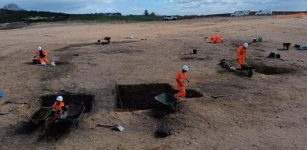 Why Was The Iron Age Village Near Elgin In Scotland Suddenly Abandoned And Burned Down?
Archaeology | Jul 29, 2022
Why Was The Iron Age Village Near Elgin In Scotland Suddenly Abandoned And Burned Down?
Archaeology | Jul 29, 2022 -
 Never-Before-Seen Amazon Rock Art Reveal People Lived With Giant Ice Age Animals
Archaeology | Dec 5, 2020
Never-Before-Seen Amazon Rock Art Reveal People Lived With Giant Ice Age Animals
Archaeology | Dec 5, 2020 -
 Mysterious Chultuns – Ancient Underground Chambers Built By The Maya – But For What Purpose?
Featured Stories | Jun 24, 2017
Mysterious Chultuns – Ancient Underground Chambers Built By The Maya – But For What Purpose?
Featured Stories | Jun 24, 2017 -
 Incredibly Well-Preserved Viking Age Ski Discovered Under Melting Ice
Archaeology | Nov 8, 2022
Incredibly Well-Preserved Viking Age Ski Discovered Under Melting Ice
Archaeology | Nov 8, 2022 -
 All 5 Genetic ‘Letters’ Of DNA May Have Been Brought By Meteorites To Ancient Earth
DNA | May 21, 2022
All 5 Genetic ‘Letters’ Of DNA May Have Been Brought By Meteorites To Ancient Earth
DNA | May 21, 2022 -
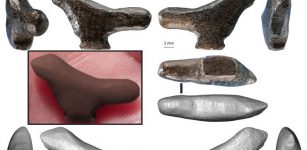 Paleolithic Standing Bird Figurine – East Asian 3-D Art – Recovered From Refuse Heap
Archaeology | Jun 23, 2020
Paleolithic Standing Bird Figurine – East Asian 3-D Art – Recovered From Refuse Heap
Archaeology | Jun 23, 2020 -
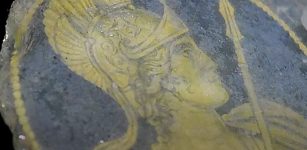 Extremely Rare Ancient Gold Glass With Goddess Roma Found During Subway Works In Rome
Archaeology | Feb 13, 2023
Extremely Rare Ancient Gold Glass With Goddess Roma Found During Subway Works In Rome
Archaeology | Feb 13, 2023 -
 X-Ray Reveal Ghostly Portrait Of Mary Queen Of Scots Hidden Underneath 16th Century Painting
Archaeology | Nov 3, 2017
X-Ray Reveal Ghostly Portrait Of Mary Queen Of Scots Hidden Underneath 16th Century Painting
Archaeology | Nov 3, 2017 -
 Archaeologists Survey Bronze Age Konar Sandal Site In Southeast Iran
Archaeology | Feb 17, 2021
Archaeologists Survey Bronze Age Konar Sandal Site In Southeast Iran
Archaeology | Feb 17, 2021 -
 Danger Lurking In The Woods – Mysterious Vanishings, Deaths And Unusual Behavior – Part 3
Featured Stories | Jul 9, 2018
Danger Lurking In The Woods – Mysterious Vanishings, Deaths And Unusual Behavior – Part 3
Featured Stories | Jul 9, 2018 -
 Surprising Ancient Secrets Of The ‘Second Thoth’ And God Osiris
Ancient Mysteries | Sep 27, 2018
Surprising Ancient Secrets Of The ‘Second Thoth’ And God Osiris
Ancient Mysteries | Sep 27, 2018 -
 On This Day In History: Richard The Lionheart Ascended The British Throne – On July 6, 1189
News | Jul 6, 2016
On This Day In History: Richard The Lionheart Ascended The British Throne – On July 6, 1189
News | Jul 6, 2016 -
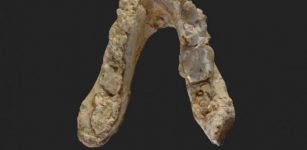 7.2-Million-Year-Old Pre-Human Remains Suggest Our First Ancestor Came From Europe Not Africa
Archaeology | May 23, 2017
7.2-Million-Year-Old Pre-Human Remains Suggest Our First Ancestor Came From Europe Not Africa
Archaeology | May 23, 2017 -
 Clues To The Mysterious Dog-Headed St. Christopher And His Connection To The Egyptian Jackal God Anubis Found?
Featured Stories | Jan 14, 2025
Clues To The Mysterious Dog-Headed St. Christopher And His Connection To The Egyptian Jackal God Anubis Found?
Featured Stories | Jan 14, 2025 -
 On This Day In History: Battle Of Lagos Took Place Between Royal Navy Of Britain and France – On August 19, 1759
News | Aug 19, 2016
On This Day In History: Battle Of Lagos Took Place Between Royal Navy Of Britain and France – On August 19, 1759
News | Aug 19, 2016



